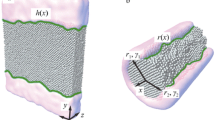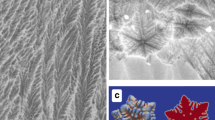Abstract
The crystal–melt interfacial free energy is an important quantity governing many kinetic phenomena including solidification and crystal growth. Although general calculation methods are available, it is still difficult to obtain the interfacial energies that differ only slightly due to anisotropy. Here, we report such a calculation of Al crystal–melt interfacial energy based on the general framework of the capillary fluctuation method (CFM). The subtle dependence of both the melting temperature and interfacial free energy at melting temperature on the crystal interface orientation was examined. For Al, the average melting temperature is obtained at 934.79 ± 5 K and the orientationally averaged mean interfacial free energy is 98.35 mJ/m2. In addition, the anisotropy of the interfacial free energy is found weak, nevertheless with the values ranked as γ100 > γ110 > γ111.





Similar content being viewed by others
References
D. Turnbull: Formation of crystal nuclei in liquid metals. J. Appl. Phys. 21, 1022 (1950).
D. Turnbull and R.E. Cech: Microscopic observation of the solidification of small metal droplets. J. Appl. Phys. 21, 804 (1950).
K.F. Kelton: Crystal nucleation in liquids and glasses. Solid State Phys. 45, 75 (1991).
D. Turnbull: Kinetics of solidification of supercooled liquid mercury droplets. J. Chem. Phys. 20, 411 (1952).
D.A. Kessler, J. Koplik, and H. Levine: Geometrical models of interface evolution. II. Numerical simulation. Phys. Rev. A 29, 3161 (1984).
D.A. Kessler and H. Levine: Velocity selection in dendritic growth. Phys. Rev. B 33, 7867 (1986).
J.S. Langer: Existence of needle crystals in local models of solidification. Phys. Rev. A 33, 435 (1986).
A. Barbieri and J.S. Langer: Predictions of dendritic growth rates in the linearized solvability theory. Phys. Rev. A 39, 5314 (1989).
E.D. Zanotto: Crystallization of liquids and glasses. Braz. J. Phys. 22, 77 (1992).
A. Cacciuto, S. Auer, and D. Frenkel: Solid–liquid interfacial free energy of small colloidal hard-sphere crystals. J. Chem. Phys. 119, 7467 (2003).
T. Haxhimali, A. Karma, F. Gonzales, and M. Rappaz: Orientation selection in dendritic evolution. Nat. Mater. 5, 660 (2006).
R.P.A. Dullens, D.G.A.L. Aarts, and W.K. Kegel: Colloidal crystal–fluid interfaces. Philos. Mag. Lett. 87, 893 (2007).
M. Gündüz and J.D. Hunt: The measurement of solid-liquid surface energies in the Al-Cu, Al-Si and Pb-Sn systems. Acta Metall. 33, 1651 (1985).
R.E. Napolitano, S. Liu, and R. Trivedi: Experimental measurement of anisotropy in crystal-melt interfacial energy. Interface Sci. 10, 217 (2002).
K. Keşlıoğlu, M. Gündüz, H. Kaya, and E. Çadırlı: Solid-liquid interfacial energy in the Al-Ti system. Mater. Lett. 58, 3067 (2004).
J.J. Hoyt, M. Asta, and A. Karma: Method for computing the anisotropy of the solid-liquid interfacial free energy. Phys. Rev. Lett. 86, 5530 (2001).
N. Akino, F. Schmid, and M.P. Allen: Molecular-dynamics study of the nematic-isotropic interface. Phys. Rev. E 63, 041706 (2001).
J.J. Hoyt and M. Asta: Atomistic computation of liquid diffusivity, solid-liquid interfacial free energy, and kinetic coefficient in Au and Ag. Phys. Rev. B 65, 214106 (2002).
M. Asta, J.J. Hoyt, and A. Karma: Calculation of alloy solid-liquid interfacial free energies from atomic-scale simulations. Phys. Rev. B 66, 100101 (2002).
J.R. Morris: Complete mapping of the anisotropic free energy of the crystal-melt interface in Al. Phys. Rev. B 66, 144104 (2002).
J.R. Morris and X.Y. Song: The anisotropic free energy of the Lennard-Jones crystal-melt interface. J. Chem. Phys. 119, 3920 (2003).
D.Y. Sun, M. Asta, and J.J. Hoyt: Crystal-melt interfacial free energies in metals: fcc versus bcc. Phys. Rev. B 69, 174103 (2004).
Y. Mu, A. Houk, and X.Y. Song: Anisotropic interfacial free energies of the hard-sphere crystal-melt interfaces. J. Phys. Chem. B 109, 6500 (2005).
R.L. Davidchack, J.R. Morris, and B.B. Laird: The anisotropic hard-sphere crystal-melt interfacial free energy from fluctuations. J. Chem. Phys. 125, 094710 (2006).
S.M. Foiles and J.J. Hoyt: Computation of grain boundary stiffness and mobility from boundary fluctuations. Acta Mater. 54, 3351 (2006).
S. Wolfsheimer, C. Tanase, K. Shundyak, R.V. Roij, and T. Schilling: Isotropic-nematic interface in suspension of hard rods: Mean-field properties and capillary waves. Phys. Rev. E 73, 061703 (2006).
X.B. Feng and B.B. Laird: Calculation of the crystal-melt interfacial free energy of succinonitrile from molecular simulation. J. Chem. Phys. 124, 044707 (2006).
D.Y. Sun, M.I. Mendelev, C.A. Becker, K. Kudin, T. Haxhimali, M. Asta, J.J. Hoyt, A. Karma, and D.J. Srolovitz: Crystal-melt interfacial free energies in hcp metals: A molecular dynamics study of Mg. Phys. Rev. B 73, 024116 (2006).
J.J. Hoyt, M. Asta, and D.Y. Sun: Molecular dynamics simulations of the crystal-melt interfacial free energy and mobility in Mo and V. Philos. Mag. 86, 3651 (2006).
J.R. Morris, M.I. Mendelev, and D.J. Srolovitz: A comparision of crystal-melt interfacial free energies using different Al potentials. J. Non-Cryst. Solids 353, 3565 (2007).
C.A. Becker, D. Olmsted, M. Asta, J.J. Hoyt, and S.M. Foiles: Atomistic underpinnings for orientation selection in alloy dendritic growth. Phys. Rev. Lett. 98, 125701 (2007).
M. Amini and B.B. Laird: Crystal-melt interfacial free energy of binary hard spheres from capillary fluctuations. Phys. Rev. B 78, 144112 (2008).
C.A. Becker, D.L. Olmsted, M. Asta, J.J. Hoyt, and S.M. Folies: Atomistic simulations of crystal-melt interfaces in a model binary alloy: Interfacial free energies adsorption coefficients, and excess entropy. Phys. Rev. B 79, 054109 (2009).
R.E. Rozas and J. Horbach: Capillary wave analysis of rough solid-liquid interfaces in nickel. EPL 93, 26006 (2011).
A.A. Potter and J.J. Hoyt: A molecular dynamics simulation study of the crystal-melt interfacial free energy and its anisotropy in the Cu-Ag-Cu ternary system. J. Cryst. Growth 327, 227 (2011).
J.R. Morris, C.Z. Wang, K.M. Ho, and C.T. Chan: Melting line of aluminum from simulations of coexisting phases. Phys. Rev. B 49, 3109 (1994).
A. Karma: Fluctuations in solidification. Phys. Rev. E 48, 3441 (1993).
W.R. Fehlner and S.H. Vosko: A product representation for cubic harmonics and special directions for the determination of the Fermi surface and related properties. Can. J. Phys. 54, 2159 (1976).
M.I. Mendelev, M.J. Kramer, C.A. Becker, and M. Asta: Analysis of semi-empirical interatomic potentials appropriate for simulation of crystalline and liquid Al and Cu. Philos. Mag. 88, 1723 (2008).
X.M. Bai and M. Li: Calculation of solid-liquid interfacial free energy: A classical nucleation theory based approach. J. Chem. Phys. 124, 124707 (2006).
C.I. Smithels: Metals Reference Book, 5th ed. (Butterworths, London, 1976); pp. 105–150.
J.J. Hoyt, Z.T. Trautt, and M. Upmanyu: Fluctuations in molecular dynamics simulations. Math. Comput. Simul. 80, 1382 (2010).
J. Mei and J.W. Davenport: Free-energy calculations and the melting point of Al. Phys. Rev. B 46, 21 (1992).
J.B. Sturgeon and B.B. Laird: Adjusting the melting point of a model system via Gibbs-Duhem integration: Application to a model of aluminum. Phys. Rev. B 62, 14720 (2000).
M.I. Mendelev, D.J. Srolovitz, G.J. Ackland, and S. Han: Effect of Fe segregation on the migration of a non-symmetric Σ5 tilt grain boundary in Al. J. Mater. Res. 20, 208 (2005).
F. Ecolessi and J.B. Adams: Interatomic potentials from first-principles calculations: The force-matching method. Europhys. Lett. 26, 583 (1994).
ACKNOWLEDGMENTS
We would like to acknowledge the financial support to this work provided by the NSF of China (041303402) and National Magnetic Confinement Fusion Science program of China under Grant (2013GB109004, 2014GB117000). The work was carried out at National Supercomputer Center in Tianjin, and the calculations were performed on TianHe-1(A) and was also supported by Tsinghua National Laboratory for Information Science and Technology. M.L. acknowledges the support provided by the National Thousand Talents Program of China.
Author information
Authors and Affiliations
Corresponding authors
APPENDIX: ERROR ANALYSIS
APPENDIX: ERROR ANALYSIS
According to Eq. (1), the interfacial stiffness γ̃ is related to the size of the capillary fluctuation modes, the later terms can be obtained from simulation directly. Therefore, the error of γ̃ comes from the distributions of capillary fluctuation modes <∣A(k)∣2 × k2>, which can be expressed as
Figure 6 illustrated the distributions of ∣A(k)∣ × k for (100)[001] orientation, picked out from 4000 interface profiles for each simulation. We found that except for the longest mode (K = 1), both ak × k and bk × k tend to be Gaussian, and the correlation coefficient r is close to 0, the statistical data are shown in Table IV.
We also conducted a Chi-square hypothesis testing for ∣A(k)∣ × k and found that most of the modes can be considered as 2D-Gaussian. In hypothesis testing, we used 6 × 6 inspection intervals, and the observations of samples χ2 are shown in Table IV. If significance level α was selected as 5%, the quantile of χ0.95(25) would be 37.652. It is found that for all modes except K = 1, ∣A(k)∣ × k follows 2D-Gaussian or similar distribution. This situation can be explained by different relaxation times, where the time correlation function42 can be expressed by
where μ is the kinetic coefficient and Γ = γ̃TM/LV, TM denotes the melting temperature and LV is the latent heat of fusion. Here, τ(t) is defined as
In Table IV, the relaxation times are given when τ = 0.1, the value can be considered as there is no relation between two interface profiles. For the longest mode (K = 1), this value is 372 ps, which is very large in simulation time, lead to dependence of ∣A(k)∣ × k. For the short mode, this independence becomes very weak and the distribution of ∣A(k)∣ × k tends to be 2D-Gaussian.
From Table IV, the averages of ak × k and bk × k (μa, μb) are close to 0, it is easy to be explained by fluctuation. The distributions of ak × k and bk × k are expressed below
where σa2 and σb2 denote the variance of ak × k and bk × k, respectively. From the statistics one can acquire
and the distribution of <∣A(k)∣2 × k2> would be
where n is the number of samples, the value of 4000 in our work. From statistics, one can get the 95% confidence intervals of <∣A(k)∣2 × k2> and γ̃(k) combining Eq. (1). Figure 7 shows the error bars of γ̃(k) for three orientations, by averaging the γ̃(k) at different k, the 95% confidence intervals of γ̃ can be acquired, as shown in Table II.
Moreover, the distribution of ∣A(k)∣2 × k2 should follow Boltzmann distribution coming from the derivation of Eq. (1) as:
Indeed, ak × k and bk × k should obey the same distribution theoretically, with σa2 = σb2 = σ2. Therefore, the distribution of ∣A(k)∣2 × k2 would be written as:
From Eq. (17), the probability density of ∣A(k)∣2 × k2 should be:
By comparison of Eq. (18) with Eq. (16), it can be found that 2σ2 = kBT/bLγ̃. At the same time, the distribution of <∣A(k)∣2 × k2> would be written as:
This equation illustrated the Gaussian distribution of <∣A(k)∣2 × k2> in the case of σa2 = σb2, while the statistical data of these two parameters in our simulations are not necessarily the same (see Table IV). Consequently, we use Eq. (15) instead of (19) for error estimation.
Rights and permissions
About this article
Cite this article
Wu, L., Xu, B., Li, Q. et al. Anisotropic crystal–melt interfacial energy and stiffness of aluminum. Journal of Materials Research 30, 1827–1835 (2015). https://doi.org/10.1557/jmr.2015.131
Received:
Accepted:
Published:
Issue Date:
DOI: https://doi.org/10.1557/jmr.2015.131






